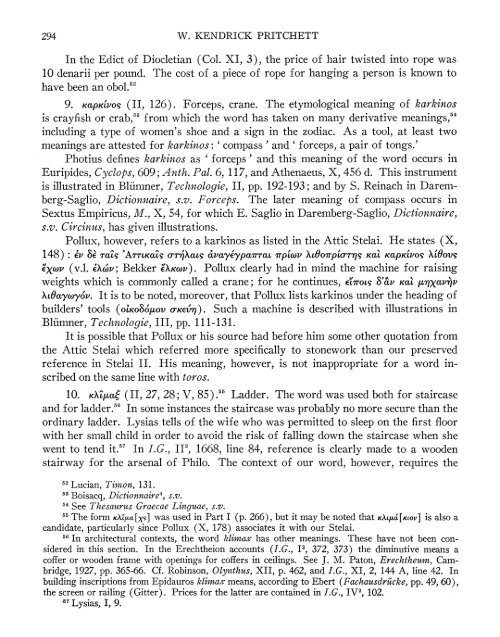the attic stelai - The American School of Classical Studies at Athens
the attic stelai - The American School of Classical Studies at Athens
the attic stelai - The American School of Classical Studies at Athens
Create successful ePaper yourself
Turn your PDF publications into a flip-book with our unique Google optimized e-Paper software.
294 W. KENDRICK PRITCHETT<br />
In <strong>the</strong> Edict <strong>of</strong> Diocletian (Col. XI, 3), <strong>the</strong> price <strong>of</strong> hair twisted into rope was<br />
10 denarii per pound. <strong>The</strong> cost <strong>of</strong> a piece <strong>of</strong> rope for hanging a person is known to<br />
have been an obol.52<br />
9. KapKtvo9 (II, 126). Forceps, crane. <strong>The</strong> etymological meaning <strong>of</strong> karkinos<br />
is crayfish or crab,3 from which <strong>the</strong> word has taken on many deriv<strong>at</strong>ive meanings,54<br />
including a type <strong>of</strong> women's shoe and a sign in <strong>the</strong> zodiac. As a tool, <strong>at</strong> least two<br />
meanings are <strong>at</strong>tested for karkinos: 'compass ' and ' forceps, a pair <strong>of</strong> tongs.'<br />
Photius defines karkinos as ' forceps' and this meaning <strong>of</strong> <strong>the</strong> word occurs in<br />
Euripides, Cyclops, 609; Anth. Pal. 6, 117, and A<strong>the</strong>naeus, X, 456 d. This instrument<br />
is illustr<strong>at</strong>ed in Bliimner, Technologie, II, pp. 192-193; and by S. Reinach in Daremberg-Saglio,<br />
Dictionnaire, s.v. Forceps. <strong>The</strong> l<strong>at</strong>er meaning <strong>of</strong> compass occurs in<br />
Sextus Empiricus, M., X, 54, for which E. Saglio in Daremberg-Saglio, Dictionnaire,<br />
s.v. Circinus, has given illustr<strong>at</strong>ions.<br />
Pollux, however, refers to a karkinos as listed in <strong>the</strong> Attic Stelai. He st<strong>at</strong>es (X,<br />
148): E' & mag 'ATTtKaig cr7TXavg avayEypa,IT'<strong>at</strong> rTptc7 v XtOOgTptGTr17s KalI KapK&O9 XVOOV<br />
E'Xcov (v.1. EAXCv; Bekker E'XKCOV). Pollux clearly had in mind <strong>the</strong> machine for raising<br />
weights which is commonly called a crane; for he continues, EtrOts 8oLV Ka1l 7-Xav-v<br />
Xdiaywyoyv. It is to be noted, moreover, th<strong>at</strong> Pollux lists karkinos under <strong>the</strong> heading <strong>of</strong><br />
builders' tools (O1KO80wOV OWKEV7-)). Such a machine is described with illustr<strong>at</strong>ions in<br />
Bliimner, Technologie, III, pp. 111-131.<br />
It is possible th<strong>at</strong> Pollux or his source had before him some o<strong>the</strong>r quot<strong>at</strong>ion from<br />
<strong>the</strong> Attic Stelai which referred more specifically to stonework than our preserved<br />
reference in Stelai II. His meaning, however, is not inappropri<strong>at</strong>e for a word inscribed<br />
on <strong>the</strong> same line with toros.<br />
10. KXqLae (II, 27, 28; V, 85) .5 Ladder. <strong>The</strong> word was used both for staircase<br />
and for ladder.56 In some instances <strong>the</strong> staircase was probably no more secure than <strong>the</strong><br />
ordinary ladder. Lysias tells <strong>of</strong> <strong>the</strong> wife who was permitted to sleep on <strong>the</strong> first floor<br />
with her small child in order to avoid <strong>the</strong> risk <strong>of</strong> falling down <strong>the</strong> staircase when she<br />
went to tend it.57 In I.G., II2, 1668, line 84, reference is clearly made to a wooden<br />
stairway for <strong>the</strong> arsenal <strong>of</strong> Philo. <strong>The</strong> context <strong>of</strong> our word, however, requires <strong>the</strong><br />
52 Lucian, Timon, 131.<br />
53 Boisacq, Dictionnaire4, s.v.<br />
54 See <strong>The</strong>saurus Graecae Linguae, s.v.<br />
55 <strong>The</strong> form KXiAT[x3] was used in Part I (p. 266), but it may be noted th<strong>at</strong> xXL6a [Ktov] is also a<br />
candid<strong>at</strong>e, particularly since Pollux (X, 178) associ<strong>at</strong>es it with our Stelai.<br />
56 In architectural contexts, <strong>the</strong> word klimax has o<strong>the</strong>r meanings. <strong>The</strong>se have not been considered<br />
in this section. In <strong>the</strong> Erech<strong>the</strong>ion accounts (I.G., I2, 372, 373) <strong>the</strong> diminutive means a<br />
c<strong>of</strong>fer or wooden frame with openings for c<strong>of</strong>fers in ceilings. See J. M. P<strong>at</strong>on, Erech<strong>the</strong>um, Cambridge,<br />
1927, pp. 365-66. Cf. Robinson, Olynthus, XII, p. 462, and I.G., XI, 2, 144 A, line 42. In<br />
building inscriptions from Epidauros klimax means, according to Ebert (Fachausdriicke, pp. 49, 60),<br />
<strong>the</strong> screen or railing (Gitter). Prices for <strong>the</strong> l<strong>at</strong>ter are contained in I.G., IV2, 102.<br />
'57 Lysias, I, 9.
















